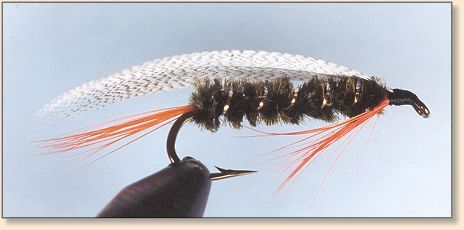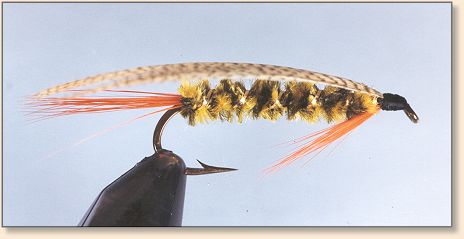|
Every experienced fly fisherman has fly patterns
he or she believes in and fishes with absolute
confidence. Most fly tiers have, in fact, developed
patterns they believe to be world-beaters at most
of their favorite fishing holes, seldom using any
other flies.
It would be difficult, for example, to convince legendary
Jim Teeny to begin a fishing trip with a fly other than
his commercially successful Teeny Nymph. It is my
understanding that he rarely ever uses any other fly.
Jim has validated the pattern in lakes and streams
worldwide. He has, in fact, booked quite a number
of world records with his fly.
There are other examples of highly successful fly
patterns that have earned a devoted following. I
know streamer fishermen who rely on the Muddler
Minnow in almost all of their fishing, sinking it
deep to imitate forage fish, and fishing it dry
as a grasshopper.
I also know a great many dry fly anglers who will
tell you with great conviction that the Humpy is
the only floating fly you need west of the Mississippi
River. Although they would have more trouble
defending that position with the Humpy, than Teeny
does with his wet fly patterns.

I know at least a dozen Idaho fly fishermen who will
tell you if they were limited to just one fly pattern
for all of their fishing, it would be the Stayner
Ducktail I happen to be a charter member of this
group.
Just how good is the Stayner?
A fishing excursion to Russia may have proved once and
for all that the fly belongs in the Fly Fishing Hall
of Fame. Boisean Ken Magee, the leader of a trout and
salmon fishing expedition to the Zhupanovo River on
the Kamchatka Peninsula in northeastern Russia,
described the group's first day on the stream.
"The guides showed us their fly boxes and made some
pattern recommendations," Magee told a Boise Valley
Fly Fishermen audience. "We thanked them and told
them we would save their flies for later."
"We showed them some Stayner Ducktails" Magee went
on, "and they had never heard of the fly. By the end
of the trip we had caught more fish with the Stayner
than with all of the patterns the guides had
recommended combined."
NEW ZEALAND FISHING
Another angling friend, the late Russ Severn of Nampa,
Idaho, once made a month-long trout fishing trip to
New Zealand. While he purchased every local fly recommended
to him when he reached the islands, he caught most of
his trout on Stayner Ducktails Ken Magee had tied for
his trip.
Magee has even added some successful Stayner variations
to his bonefish collection.
Invented by the late Ruel Stayner, former Twin Falls,
Idaho sporting goods store owner and master fly fisherman,
the pattern has in the past 25 years become a staple of
fly fishermen all over the country. The Stayner Ducktail
was one of the first flies I ran when I initiated a
"Fly of the Week" feature in the Boise newspaper in
the early 70s.
Originally designed to imitate the perch fry in Idaho's
Magic Reservoir, the pattern does an even better job in
suggesting shiner minnows or trout fry. Anglers should
remember that almost all game fish eat other little fish.
The food chain may begin with algae, copepods and daphnia,
but it ends with the largest fish in a fishery eating
their smaller brethern.
And it's not just a trout fly. While I'll admit I catch
more smallmouth bass with some type of crawdad pattern,
the Stayner is usually my second choice. When I'm
fishing a lake or pond that produces large bluegill
(fish in the 9- to 12-inch range), my fly of choice
is usually the Stayner Ducktail.
Believe it or not, the pattern can also be one of the
most deadly flies for channel catfish. While that may
surprise some fly rodders, when anglers understand
that the channel catfish's natural foods isn't kidney
meat and stink baits, but crawdads, shiners, dace,
chubs, and any other life forms the catfish can kill
for a meal, they will imitate those aquatic trout
foods when searching for channel catfish with a fly rod.
THE STAYNER IN STREAMS
Although the Stayner is used more in lakes and reservoirs
than in streams, I've hooked more lunker trout in my
favorite southwest Idaho blue-ribbon trout stream with
the Stayner than any other single fly. When things get
tough on the South Fork of the Boise, I'll put on a
hi-density sink-tip fly line and fish the fly through
some of the better holding areas.
New fly patterns come and go. Some hang around for a few
seasons, then quietly disappear. But now and then a fly
comes along that not only becomes a local standard, but
gains national and international prominence.
The Stayner Ducktail is just such a pattern.
In the beginning I tied and fished the Stayner in sizes 6
through 10. I still use those sizes when the prey base of
my quarry are large minnows. But during the past three
or four years, I've been experimenting with sizes 14
through 16. In most of my trout fishing I now find
sizes 12 and 14 are my most productive sizes.
I have a theory: I believe the smaller Stayners appeal
more to trout because they represent an easier meal than
do the larger sizes. As bait fish grow larger, most are
faster and quicker, better equipped to elude predator
fish. While this theory flies in the face of the "give
big fish a mouth-full," it works for me. I believe if
trout could carry on a conversation with anglers, they
would probably ask for minnows they can easily capture.
I've experimented with variations over the years. I suppose
I've tried 10 or 12 different colors of ducktails. Most
have produced only limited successes. The one variation
that has survived has become more productive for me than
the original. I named it my Blonde Stayner. I think it
does a better job suggesting the fry of: perch, dace,
suckers and chubs.
Since I am a bit of a nervous fly fisher, I enjoy fishing
ducktails. I fish a quick retrieve a lot of the time.
In presenting ducktails to hungry fish, the angler
should work his line to make his fly dart like wounded
prey.

STAYNER DUCKTAIL
Hook: Mustad 9672, or 3X long equivalent. Sizes 6 - 14.
Thread: Black, 6/0 pre-waxed.
Tail: 10 or 15 orange saddle hackle fibers, ½ body length.
Body: Dark-olive chenille, sizes medium or small.
Ribbing: Gold 16/18 mylar tinsel, 4 or 5 wraps.
Beard: 10 or 15 orange saddle hackle fibers, reaching
to hook point.
Wing: Natural mallard flank feather, tied flat,
reaching to end of tail.
Head: Black.
And here is my favorite, the Blonde Stayner.

BLONDE STAYNER
Hook: Mustad 9672, or 3XL equivalent. Sizes 6 - 14.
Thread: Black, 6/0 pre-waxed.
Tail: 10 to 15 orange saddle hackle fibers, 12; body length.
Body: Yellow and dark olive variegated chenille,
sizes medium or small.
Ribbing: Gold 16/18 mylar tinsel 4 or 5 wraps.
Beard: 10 to 15 orange saddle hackle fibers,
reaching to hook point.
Wing: Woodduck dyed mallard flank feather, tied
flat, reaching to end of tail.
Head: Black.
~ Marv
About Marv
Marv Taylor's books, Float-Tubing The West,
The Successful Angler's Journal,
More Fragments of the Puzzle, (Volume I) and More
Fragments of the Puzzle, (Volume II) are all available from
Marv. You can reach Marv by email at
marvtroutman@juno.com or by phone: 208-322-5760.
|





